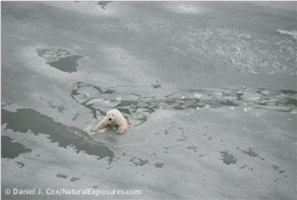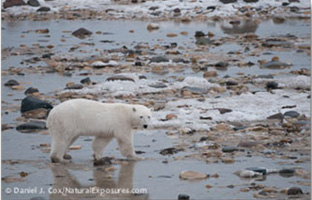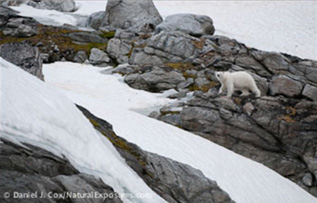|
Planning Now for the Challenges Ahead
 Scientists who work with polar bears are already seeing the effects of human-caused global warming on some polar bear populations. So far these changes, while serious, have been gradual. Scientists who work with polar bears are already seeing the effects of human-caused global warming on some polar bear populations. So far these changes, while serious, have been gradual.
But natural variation within the climate system, combined with the chronic loss of ice already taking place, is likely soon to create massive sea ice losses in some parts of the Arctic in a single year--with a catastrophic impact on the polar bears living there.
To help managers plan for such a crisis, an international team of 12 scientists--including Dr. Andrew Derocher, professor of biological sciences at the University of Alberta, and Dr. Steven C. Amstrup, PBI's chief scientist--have published a paper in Conservation Letters that provides an overview of available management options.
 "We've known for years that a crisis is coming," says Derocher, senior author of the paper and a scientific advisor to PBI. "The sea ice habitat that polar bears depend on for their survival is declining, and freeze up and break-up patterns have changed as the Arctic has warmed. So far, the decline has been mostly linear. But modeling shows that a single bad ice year with a prolonged ice-free period could have a devastating impact on already stressed populations." "We've known for years that a crisis is coming," says Derocher, senior author of the paper and a scientific advisor to PBI. "The sea ice habitat that polar bears depend on for their survival is declining, and freeze up and break-up patterns have changed as the Arctic has warmed. So far, the decline has been mostly linear. But modeling shows that a single bad ice year with a prolonged ice-free period could have a devastating impact on already stressed populations."
"Ultimately, the only way to save polar bears is to save their sea ice habitat by reducing the greenhouse gas emissions that cause global warming," says PBI chief scientist, Dr. Steven C. Amstrup.
"Eventually, all years will be bad for sea ice and the bears that depend on it, unless we take action on climate change. But in the nearer term, wildlife managers need to plan for individual bad ice years that will precede the ultimate loss of arctic ice. And the time to do so is now--not during a crisis when starving polar bears are stranded onshore."
Unfortunately, the media focus has largely missed the paper's point with headlines like "Scientists recommend feeding polar bears." But the authors emphasise that they are not recommending specific actions. Rather, given the expected public and political pressure, the paper reviews anticipated management options, including some drastic measures such as supplementary feeding, relocations, or various kinds of rescue. While not recommending one policy over another, they point out the pros, cons, and costs that will confront managers when a crisis comes.
 Why explore such options? Amstrup says that public pressure will be enormous for managers to do something in the face of a catastrophe. "People will respond emotionally to the sight of starving polar bears," he says "Because the only real solution, addressing climate change, will not offer immediate relief of the symptoms, we felt it was important to inspire managers to begin to think about on-the-ground responses so they can be prepared." Why explore such options? Amstrup says that public pressure will be enormous for managers to do something in the face of a catastrophe. "People will respond emotionally to the sight of starving polar bears," he says "Because the only real solution, addressing climate change, will not offer immediate relief of the symptoms, we felt it was important to inspire managers to begin to think about on-the-ground responses so they can be prepared."
"If we do gain control of carbon emissions," he adds, "these actions may help preserve more bears in more areas than would otherwise have been the case."
The scientists also stress that the success of rehabilitation, short-term housing of problem bears, and other possible interventions will depend on the degree of advance planning done by managers and policy makers.
While the identified strategies could help some polar bears in the short term, stopping climate change is the only long-term solution for polar bears and their threatened sea ice habitat, the authors say.
PLIGHT OF THE POLAR BEAR: (ARTICLE FROM THE SUNDAY TIMES)
Polar bears drown as ice shelf melts by Will Iredale
SCIENTISTS have for the first time found evidence that polar bears are drowning because climate change is melting the Arctic ice shelf.
The researchers were startled to find bears having to swim up to 60 miles across open sea to find food. They are being forced into the long voyages because the ice floes from which they feed are melting, becoming smaller and drifting farther apart.
Although polar bears are strong swimmers, they are adapted for swimming close to the shore. Their sea journeys leave them them vulnerable to exhaustion, hypothermia or being swamped by waves.
According to the new research, four bear carcases were found floating in one month in a single patch of sea off the north coast of Alaska, where average summer temperatures have increased by 2-3C degrees since 1950s.
The scientists believe such drownings are becoming widespread across the Arctic, an inevitable consequence of the doubling in the past 20 years of the proportion of polar bears having to swim in open seas.
“Mortalities due to offshore swimming may be a relatively important and unaccounted source of natural mortality given the energetic demands placed on individual bears engaged in long-distance swimming,” says the research led by Dr Charles Monnett, marine ecologist at the American government’s Minerals Management Service. “Drowning-related deaths of polar bears may increase in the future if the observed trend of regression of pack ice continues.”
The research, presented to a conference on marine mammals in San Diego, California, last week, comes amid evidence of a decline in numbers of the 22,000 polar bears that live in about 20 sites across the Arctic circle.
In Hudson Bay, Canada, the site of the most southerly polar bears, a study by the US Geological Survey (USGS) and the Canadian Wildlife Service to be published next year will show the population fell 22% from 1,194 in 1987 to 935 last year.
New evidence from field researchers working for the World Wildlife Fund in Yakutia, on the northeast coast of Russia, has also shown the region’s first evidence of cannibalism among bears competing for food supplies.
Polar bears live on ice all year round and use it as a platform from which to hunt food and rear their young. They hunt near the edge, where the ice is thinnest, catching seals when they make holes in the ice to breath. They typically eat one seal every four or five days and a single bear can consume 100lb of blubber at one sitting.
As the ice pack retreats north in the summer between June and October, the bears must travel between ice floes to continue hunting in areas such as the shallow water of the continental shelf off the Alaskan coast — one of the most food-rich areas in the Arctic.
However, last summer the ice cap receded about 200 miles further north than the average of two decades ago, forcing the bears to undertake far longer voyages between floes.
“We know short swims up to 15 miles are no problem, and we know that one or two may have swum up to 100 miles. But that is the extent of their ability, and if they are trying to make such a long swim and they encounter rough seas they could get into trouble,” said Steven Amstrup, a research wildlife biologist with the USGS.
The new study, carried out in part of the Beaufort Sea, shows that between 1986 and 2005 just 4% of the bears spotted off the north coast of Alaska were swimming in open waters. Not a single drowning had been documented in the area.
However, last September, when the ice cap had retreated a record 160 miles north of Alaska, 51 bears were spotted, of which 20% were seen in the open sea, swimming as far as 60 miles off shore.
The researchers returned to the vicinity a few days later after a fierce storm and found four dead bears floating in the water. “We estimate that of the order of 40 bears may have been swimming and that many of those probably drowned as a result of rough seas caused by high winds,” said the report.
In their search for food, polar bears are also having to roam further south, rummaging in the dustbins of Canadian homes. Sir Ranulph Fiennes, the explorer who has been to the North Pole seven times, said he had noticed a deterioration in the bears’ ice habitat since his first expedition in 1975.
“Each year there was more water than the time before,” he said. “We used amphibious sledges for the first time in 1986.”
His last expedition was in 2002, when he fell through the ice and lost some of his fingers to frostbite.
For more information on the plight of the polar bear and to read what the top scientists have to say please look at this site:
Must have a link to this site: www.polarbearsinternational.org
For every unit we install we will donate R50 to the Polar Bears International.
|

